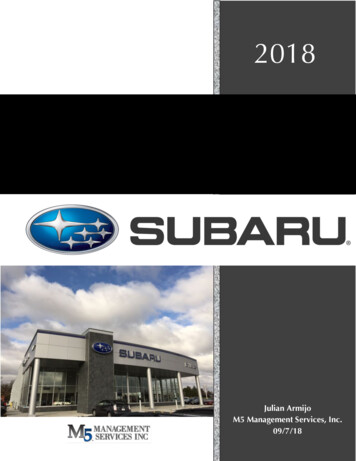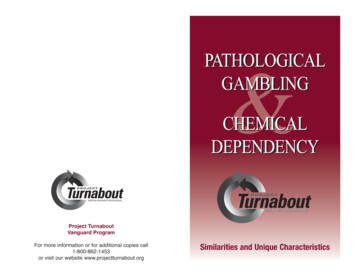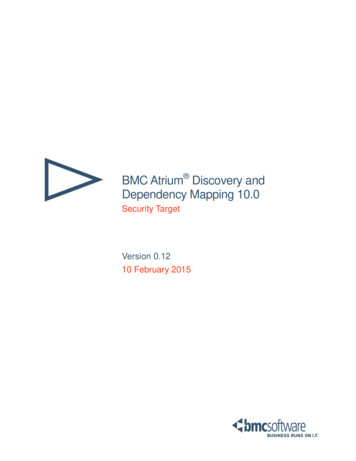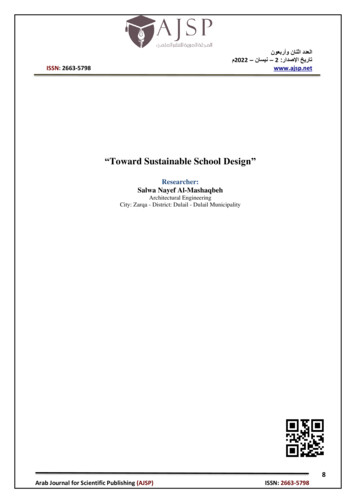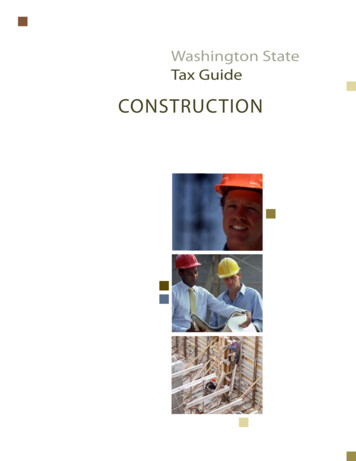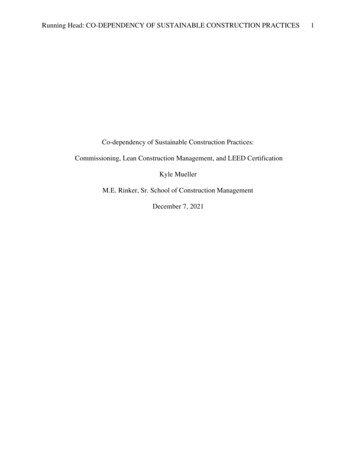
Transcription
Running Head: CO-DEPENDENCY OF SUSTAINABLE CONSTRUCTION PRACTICESCo-dependency of Sustainable Construction Practices:Commissioning, Lean Construction Management, and LEED CertificationKyle MuellerM.E. Rinker, Sr. School of Construction ManagementDecember 7, 20211
CO-DEPENDENCY OF SUSTAINABLE CONSTRUCTION PRACTICES2Abstract:LEED building certifications (LEED), building commissioning (Cx), and Leanconstruction methods (Lean) are drastically different in principle but serve a similar purpose; toincrease savings, efficiency, and building quality by conserving time, money, and resources. Asthe construction industry shifts toward building more sustainably, it seems that there is aprescriptive formula for successfully producing a “sustainable” building that involves all three ofthe aforementioned processes being used. It begs the question: are LEED, Cx, and Leandependent on one another for their success? By performing a literary analysis including two casestudies, the relationships between LEED, Cx, and Lean were compared to determine theirrelevance and overall benefit to a construction project. The research yielded that if properlyexecuted, a project using Lean construction methods will often achieve a LEED certification. ALEED certification, however, requires that regular commissioning checks are performed as aprerequisite. Interestingly, LEED and Commissioning require a willing contractor who isinvolved early on in the project and uses integrated project delivery methods (Lean construction).Independently, each of the aforementioned quality assurance methods work effectively toimprove sustainability, increase building efficiency, and reduce costs. That being said,independently they will not yield a truly sustainable building, LEED requires Commissioning,and both require Lean construction methods to effectively integrate design and construction.
CO-DEPENDENCY OF SUSTAINABLE CONSTRUCTION PRACTICES3Sustainable Development in Construction:Sustainable development in Construction, while not a new topic, is one that has been atthe forefront of the construction industry since the start of the new millennium. Sustainabledevelopment is generally defined as the ability for developers to meet the needs of the currentgeneration of users without negatively impacting the needs of future generations of users. Whatbegan as an experimental building process has developed into a multifaceted practice that is fullyengrained in most major construction projects today. New practices have been developed to aidin constructing sustainable buildings, such as the Leadership in Energy and EnvironmentalDesign (LEED) Rating System, Lean Construction Management Principles, and ProjectCommissioning. These practices depend have become heavily dependent on one another toproduce a successful sustainable construction project.Methodology:Literary Analysis:In order to further explore the codependency of these independently formed constructionprocesses, two separate approaches will be taken. First, a literary analysis will be conducted onexisting articles detailing performance standards for successful LEED, Commissioning, and Leanconstruction processes and their idiosyncrasies. Then, the results of the literary analysis will becompared and contrasted in an effort to describe the relationships between the processes.General Definitions:To set a basis for comparison, it is essential to have the three following constructionprocesses well defined. Each of the following definitions are paraphrased directly from the bodywho created the construction process.Leadership in Energy and Environmental Design (LEED) Rating System:In 1993 the United States Green Building Council (USGBC) was founded in an effort topromote sustainable and energy efficient construction and design. Soon after its foundation, itdeveloped a set of standards for sustainable construction and design principles later to be knownas the LEED rating system. Every few years since its formation, the LEED rating systemundergoes an in-depth overhaul to ensure it stays relevant with current construction practices. Asthe system has evolved, it has moved from being an ecologically based rating system to ahuman-quality-of-life-based rating system. In its latest version LEED v4.1, a new focus has beenplaced on the following aspects of building construction and design: material selection, indoorair quality, quality of construction, and creating community. In addition to this, LEEDcertifications are also extending beyond new construction to existing structures and renovations.This is largely attributable to the practice called commissioning, which allows existing buildingsystems to be managed or improved to achieve a LEED accreditation. (Baker, 2018).
CO-DEPENDENCY OF SUSTAINABLE CONSTRUCTION PRACTICES4Commissioning in Building Construction (Cx):Building Commissioning (Cx) is a professional practice used in new or existingconstruction projects to ensure that buildings are constructed and or operated according to theowners’ requirements. It is typically a process that begins at the same time as the design and ismonitored throughout the course of the project via commissioning checks. These commissioningchecks ensure that specific aspects of construction are progressing per the most current, approvedconstruction drawings. If commissioning checks fail, the failed construction becomes the focusof the project until it is rectified, if it passes it is protected and associated building systems areconsidered operational. When successfully practiced, building commissioning has the potentialto reduce the number of change orders, RFIs, resubmittals, and rework on any given project.(WBDG, 2016).Lean Construction Management Principles:Lean construction, at its basics, is a management principle dedicated to maximizingconstruction value and minimizing construction waste. Maximizing construction value entailscoordinating labor in a logical and meaningful way, creating detailed schedules that optimizetradesman performance, reducing construction waste by ensuring proper construction, andmaximizing productivity to reduce project timelines. Minimizing construction waste entailsintegrating the design and construction teams to reduce rework, monitoring processes andprogress to ensure proper construction, and minimizing material use to reduce constructionwaste. Lean construction tends to lead to frequent reflection within the project team, whereunderutilized, unused employees, or other resources are discussed and reallocated to improveefficiency. More often than not, a project utilizing Lean construction management principles willalso make use of LEED accreditations and commissioning to achieve its goals.Literary Analysis:Lean Construction (LC) Framework and Sustainability:To gain a greater understanding of the intricacies of Lean Construction, it is essential tolook at its foundations which were outlined in a Technical Report by Lauri Koskela in Septemberof 1992 called “Application of The New Production Philosophy to Construction.” In her report,Koskela lists a set of heuristic principles that are the foundations of Lean Construction whichconsists of the following:1.Reduce the share of non-value adding activitiesWhere a non-value-added activity is one which does not produce a measurable outcome and istherefore inefficient and considered “waste.” Koskela informs that hierarchal organizations, bydesign, have non-value-added activities such as inspecting, moving, and waiting.2.Increase output value through systematic consideration of customer requirementsValue is fundamentally added when customer requirements can be fulfilled and or exceeded.Customer requirements must be first and foremost considered.3.Reduce Variability
CO-DEPENDENCY OF SUSTAINABLE CONSTRUCTION PRACTICES5Streamlining and simplifying a process reduces variability. No two construction objects areexactly identical, but steps can be implemented to reduce deficiencies and significant differences.4.Reduce the Cycle TimeCycle Time Processing time inspection time wait time move time. By reducing cycletime, each of the components of the above equation must shrink to their minimum. Unnecessarycomponents, such as wait or move time are subject to being removed.5.Simplify by minimizing the number of steps, parts, and linkages,Reduction of components, parts within a component, actual assembly steps, and simplification ofbuilding processes. If building processes are more intuitive and require fewer immediate skills,production time will decrease.6.Increase output flexibilityContrary to simplifying and streamlining building processes, it is important to increase flexibilityin design and end results. This is achievable by providing modular design options and allowingcustomization beyond modules as late in the design process as possible.7.Increase process transparencyLack of transparency helps to hide flaws in the construction process. Transparency in this casebeing knowledge of the construction process. Improving transparency by creating organizationalstructures, physically attainable goals, and publicly displaying all information about theconstruction process improves work quality and duration.8.Focus control on the complete processControlling the complete process involves creating a measurable metric for success andimplementing a strong authority figure who will guide a team towards a goal.9.Build continuous improvement into the processBy engaging employees, setting realistic and measurable metrics for success, and reflecting onwork performed, it is possible to constantly improve the construction process.10.Balance flow improvement with conversion improvementMaintaining a balance between workflow improvement and the actual construction processimprovement is essential to a profitable and successful project.11.BenchmarkTo create a benchmark is to reflect on the work performed and project future plans to improvethe work performed per the prescribed steps above.Fundamentals of Lean Construction and the Idea of Waste:The fundamental framework for a Lean construction project, as originally written, baresno mind to the ecological benefits and deficits of the construction process unless it comes at acost to the overall project. This meaning, if the owner of the project is not greatly concerned withsocial responsibility and sustainability, a Lean construction project is not greatly concernedeither.Waste is a term that is frequently used by both Koskela and by the Lean ConstructionInstitute (LCI). Reduction of waste, as a resource, is a blanket term for all resources aconstruction company has to offer. In terms of the word waste, employee productivity, employeetime, re-work due to poor craftsmanship, design flaws, etc. can be considered a resource whosewaste can be reduced. With the topic of sustainability in mind, waste was considered at facevalue to represent excess material consumption. Koskela goes on to compare material waste dueto redesign, to resource waste due to employee injury and safety. She compares a paraphrased
CO-DEPENDENCY OF SUSTAINABLE CONSTRUCTION PRACTICES6quote from (Cnudde 1991) stating that rework as a result of poor-quality accounts for 10% - 20%of construction costs, with a paraphrased quote from (Levitt & Samuelson) stating that safetyrelated costs account for 6% of all construction costs on a project. Material wasted is the same astime wasted when both instances of waste are in reference to money.In the entire laid out framework, sustainability was not discussed in depth outside of theabove stated profit, hinting that it is not an intended consequence of the management principle.That being said, that does not mean there isn’t room for it to be used. Each of the 11 aspects offramework are able to be referenced via a lens of sustainability should the Owner desire. Thereinlies the significant difference between Lean Construction, LEED, and Commissioning. Leanconstruction is a general contractor’s method of project delivery which is not directly requestedby the owner, nor does it affect the owner. LEED and Commissioning, however, are twoprocesses that are only completed by a general contractor if they are required by the Owner. Inshort, Lean Construction is a means to an end, while LEED and Commissioning are more so anend result.LEED Accreditation and Lean ConstructionLEED Accreditation is a prescriptive scorecard of items which are representative of thelargest areas of improvement for the construction industry in terms of sustainability. The 8 mainsections are listed below to the right and apply to one of the nine different construction typeslisted below to the left.8 Main Sections of LEED Scorecard9 Types of Applicable Construction--Sustainable SitesWater EfficiencyEnergy and AtmosphereMaterials and ResourcesIndoor Air QualityInnovation in DesignLocation and TransportationInnovationNew Construction and Major RenovationsExisting BuildingsCommercial InteriorsCore and ShellSchoolsRetailHealthcareHomesNeighborhood DevelopmentThe current Scorecard requires 40 – 49 points to be Certified, 50 – 59 points to receiveSilver Certification, 60 – 79 points to receive Gold Certification, and 80 – 110 points to receivePlatinum certification. In order for a project team to achieve any level of certification, diligentand early coordination is required between the Owner, Design team, and Construction team.Earning LEED credits is often not the job of the contractor. Rather, the owner and the designteam delegate specific tasks and require certain products which the contractor carries out in orderto satisfy the LEED credit. Because this decision-making process does not typically involve thecontractor, “ . little has been published regarding the role of the constructor in the certificationprocess.” (Schaufelberger, 2009).In a study performed by John Schaufelberger and Joshua Cloud in 2009 for theUniversity of Washington, 29 contractors were asked to report on their involvement in achievingLEED credits. The contractors responded that they were responsible for Construction waste
CO-DEPENDENCY OF SUSTAINABLE CONSTRUCTION PRACTICES7diversion, reuse of 5% to 10% of all materials, location and use of local materials, location anduse of recycled materials, use of rapidly renewable materials, management of indoor air quality,and location/installation of low emitting materials on most of their LEED projects. These creditsare not difficult to achieve but considering the lack of structure and training for contractors, theyare rather difficult to track. Tracking a Low-Emitting material, for example, requires thecontractor to submit Health Product Declaration Data Sheets, calculate the exact volume andsquare footage of product installed, ensure that the product meets Option 1 or Option 2 (LEEDCriteria), and is third party verified to conform to a specific standard or regulation. Thisinformation should be supplied by the manufacturer of the product to the subcontractor, whothen supplies the information to the contractor. Along the way, information can be lost or notcommunicated to the contractor resulting in an incomplete LEED credit entry and potentially alost point.When asked to evaluate their end of the LEED Certification process. 16 of the 22contractors responded that the process was not straightforward but rather difficult, one of the 22responding that the process was extremely difficult.Figure 1: Respondent Evaluation of LEED Certification ProcessThe contractors were also asked if the tracking process required more than a reasonableamount of time to complete, to which 14 of the 22 responded that it took “A lot longer” than theyhad planned for.Figure 2: Additional Time Needed for LEED DocumentationLastly, the contractors were asked to provide the approximate increase in costs that wereincurred as a result of the process. 11 out of 22 reported that the certification costs less than 1%of project costs.Figure 3: Additional Cost Incurred by Constructor on LEED-Certified Project
CO-DEPENDENCY OF SUSTAINABLE CONSTRUCTION PRACTICES8When asked what they would do differently to achieve more points, common responseswere:-“Collaborate with the owner and design teams as early as possible tomaximize the use of the expertise of the entire project team”“Start the documentation process and coordination with thesubcontractors as early as possible.”“Contractually obligate the subcontractors to provide the necessarydocumentation.”After reviewing the above case study by John Schaufelberger and Joshua Cloud andunderstanding the Lean Construction process as laid out by Lauri Koskela, it seems evident thatboth construction processes could benefit from one another. The LEED accreditation process,from the perspective of a contractor, is convoluted and not incredibly prescriptive. There are longpaper trails and information that is relatively difficult to get from suppliers if there is not a directcontractual relationship. Streamlining the process of documentation will indubitably increase theperformance of a general contractor in terms of both efficacy and efficiency. The Leanconstruction process also begins as soon as the contract is awarded which, as the contractorconsensus states, is the most effective way to score more LEED points. Constant collaborationbetween the contractor, the designer, and the owner is the best way earn a higher LEEDcertification which also demonstrates higher building quality and a better life cycle assessment.The Lean construction process can benefit from LEED construction projects accordingly. Withthe purpose of a Lean project being constant improvement, streamlining of otherwise difficultprocesses, and pleasing the client, it would seem that a more efficient building whose teams areconstantly collaborating and evolving would be an appropriate endeavor to pursue.Professional Commissioning and LEED ProjectsCommissioning often plays a significant role in a project receiving LEED accreditationwith multiple credits actually requiring a Cx to be completed. One specific credit which is aprerequisite of all LEED projects is: Prerequisite 1, Fundamental Commissioning of a BuildingsEnergy Systems. An additional two credits can be earned by achieving the more rigorousEnhanced Commissioning. (USGBC 2009). Typical Commissioning Methodologies, as laid outby William L. Gillis and Elizabeth A. Cudney with Frontiers of Engineering Management in thearticle “A Standard for the Commissioning Process,” follow a four-phase approach. Respectivelythose phases are:Phase I: Pre-DesignThe commissioning process begins by identifying the Owner’s Project Requirementswhich provide the design team with enough information to form the Basis of Design. These twodocuments are compared in a Quality Control process called the Quality Function Deployment(QDF) which “ captures the voice of the customer and translates it into engineeringcharacteristics that are carried into production and service, ensuring that the final product meetsthis voice.” (W. L. Gillis and E. A. Cudney, 2015). QDF is a four-phase approach which servesas the basis for most modern commissioning professionals. The comparison of the twoaforementioned documents brings to light deficiencies between the design and the owner’srequirements which are then corrected.
CO-DEPENDENCY OF SUSTAINABLE CONSTRUCTION PRACTICES9Phase II: DesignOnce the design phase of the project is completed, it is once again checked against theBasis of Design for deficiencies. The deficiencies are individually addressed, and final designsare made, specifications are generated, construction checklists are developed, and constructioncoordination reviews begin. The goal of this process is to create the most wholistic and completebid package.Phase III: ConstructionThe third phase focuses on the construction process and checking the actual buildingagainst the design specifications, the construction checklists, the construction coordination plan,and the owner deficiency log. The third phase essentially serves as a quality control and qualityassurance check that runs the length of the project.Phase IV: O&MThe fourth and final phase of building commissioning, Operation & Maintenance (O&M)serves to ensure the long-term success of the project. All manufacturers have O&M manuals thatcome with their respective products. It is the job of the general contractor to collect these fromall manufacturers and subcontractors and provide them to the owner and CxA. The O&Mmanuals are used for training purposes for the future staff of the finished construction project.Commissioning Case Study:In the same article by William L. Gillis and Elizabeth A. Cudney, “A Standard for theCommissioning Process,” a case study was performed on two similar construction projects, onewhich successfully utilized commissioning (#2) and the other that did not (#1). The table belowshows a summarization of the case study findings. It can be seen that building 1 required 312RFIs and 173 Change Orders to be submitted hinting at significantly underdeveloped designdrawings where the design was frequently changing, costing the contractor 3.9 million.Additionally, 75 workmanship warranties were submitted within the one-year warranty period.The most telling result is the amount of design and construction issues brought up by acommissioning consultant, which was zero. This meaning that there were no discrepancies notedbetween the owner and the designer until construction began, which suggests that either thedesigner perfectly captured the owners wishes or did not consult the owner at all. Building #2, onthe other hand, sorted out nearly all design discrepancies (263 issues) before construction beganand as a result only needed to process 23 RFIs and 34 Change orders for a total cost of 0.2million. Additionally, the workmanship warrant period passed, and no warranties were submittedor claimed suggesting that the quality of the construction and installations was enough to notrequire any rework after turnover.
CO-DEPENDENCY OF SUSTAINABLE CONSTRUCTION PRACTICES10Professional Commissioning and Lean Construction:Professional Commissioning, at its core, serves to eliminate rework and solve significantproblems before they arise. It is a system of checks and balances that help the overall project tocontinue improving and evolving. While there is more work to be done beforehand in the designand preconstruction phases, the time and money spent is recovered in the form of fewer RFI’s,fewer claimed Warranties, and greater building performance. Similarly, to Lean construction,Commissioning is constantly working in the best interest of the owner from the creation of theBasis of Design through the handover of the O&M manuals. Lean construction andCommissioning fundamentally serve incredibly similar purposes but are different in that one is aconstruction management technique and the other is an enforcer of quality assurance and qualitycontrol. This similarity begs the question, would a project using lean construction managementever need to use a CxA? The sheer nature of Lean construction is to constantly improve andmake mistakes obsolete, such is the nature of commissioning. In the current state of theconstruction industry, construction management is not a perfect science, so commissioning is avital tool to aid in improving efficiency and quality of construction. In the future, however, whenthe construction management process is perfected with the use of Lean construction managementtechniques it may be unnecessary to have a second quality assurance technique likecommissioning.Codependency of Lean Construction, Commissioning, and LEED in Today’s Market:To discuss the codependency of Lean construction, Commissioning, and LEED intoday’s market, it is necessary to create a scenario that reflects the real world. Today, most newconstruction projects aim to receive some degree of LEED certification. Utilizing this fact, thatthe owner wants this hypothetical new construction to be a LEED certified project, the followingcodependences become evident. Immediately, it is evident that LEED certifications aredependent on Professional Commissioning in more ways than one. As previously discussed,Commissioning is a prerequisite for all LEED projects. Additionally, with Commissioningbeginning at the design phase of the project, Commissioning Authorities are involved in theselection and approval of most components to be installed. Commissioning aside, LEED certifiedprojects also depend heavily on a strong management team to successfully execute thedocumentation process. As the case study by John Schaufelberger and Joshua Clouddemonstrated, achieving a LEED certification as a contractor would be made significantly easierif there was more communication between with the Owner and Architect earlier on in theprocess. This is prescriptively what Lean Construction aims to coordinate, early communicationbetween the design and construction team to better achieve the owner’s requirements. In thissame respect, Commissioning essentially aims to achieve the same purpose; manage the designand construction teams to assist in creating a project per the owner’s requirements. Leanconstruction management makes use of commissioning professionals to find short comings of itsown process and drive improvement internally all while achieving a successful project by theowner’s standards.
CO-DEPENDENCY OF SUSTAINABLE CONSTRUCTION PRACTICES11Principles of Lean Construction Management as it Relates to CommissioningLean Construction PrincipleHow it is Achieved by CommissioningReduce the Share of Non-Value AddingNon-Value Adding Activities are managedActivitiesby ContractorIncrease Output Value through SystematicHeavy Focus on Creating Owner ProjectConsideration of Customer RequirementsRequirements (OPRs)Early Design Coordination to EliminateReduce VariabilityRework, Monitored during Construction viaDeficiency LogsReduce Cycle TimeCycle Time Managed by ContractorSimplify by Minimizing the NumberMeans and Methods Managed by Contractorof Steps, Parts, and LinkagesAims to reduce output Flexibility Increase Output FlexibilityDeficiency LogInstallations are Compared to CommittedIncrease Process TransparencyDesign Drawings and Monitored by aDeficiency LogFocus control on Owner ProjectFocus Control on the Complete ProcessRequirementsBuild Continuous Improvement into theFocus on Correct Installation, Monitored byProcessDeficiency LogBalance Flow Improvement with Conversion Driven by Design Requirements, not ProcessImprovementImprovementBenchmarkServes as the BenchmarkFigure 4: Principles of Lean Construction Management as it Relates to Commissioning. 11 essential Lean Construction Principles laid out andhow Commissioning directly achieves them. Commissioning acts as a Quality Control/Quality Assurance method.In a perfect scenario, where Lean construction has fully optimized the constructionprocess, Commissioning is not a necessity. The project is completed correctly the first time anddoes not require an external quality check. In today’s market, contractors do not provide the inhouse personnel to perform the job of a commissioning agent who is therefore a necessity toachieve the desired results.Figure 5: Illustration of the Hierarchy of Dependency for the Construction Principles in a Real-World Situation. LEED Directly Depends on bothCommissioning and Lean. Commissioning and Lean Depend on one another but are not entirely necessary for the success of a typical project.
CO-DEPENDENCY OF SUSTAINABLE CONSTRUCTION PRACTICES12In exploring the relationships that these individual processes have with one another, it’simportant to recognize which team member each of the processes is performed by. Typically, thedecision to pursue a LEED certification is a decision that is made by the owner and the designteam. The Contractor is expected to execute the LEED certification requirements withoutactually having much say in what is being done. The Commissioning process is typicallyperformed by the engineering/design team in coordination with the Owner. Again, the contractoris not involved in the commissioning process until bidding and construction. The Leanconstruction management process is typically spearheaded by the contractor on behalf of theOwner, or it may be a requirement of the owner that the project is managed a certain way.Regardless, the contractor using Lean Construction management in this case is the capstone inthe pursuit of a sustainable building in that LEED certified projects are difficult to achievewithout the use of it. The most effective way for a project to be constructed sustainably would beto utilize Lean construction management techniques, alongside Professional commissioning, toachieve a LEED certification. As such, these individual processes and relationships arecodependent on one another for the success of all.
CO-DEPENDENCY OF SUSTAINABLE CONSTRUCTION PRACTICES13References:Baker, M. (2018, December 11). LEED: Past, present, and future. U.S. Green Building Council.Retrieved October 29, 2021, from ndfuture.Cnudde, M. 1991. Lack of quality in construction - economic losses. European Symposium onManagement, Quality and Economics in Housing and Other Building Sectors, Lisbon,September 30 - October 4, 1991. Proceedings, pp. 508 - 515.Gillis, W. L., & Cudney, E. A. (2015). A standard for the commissioning process. Frontiers ofEngineering Management, 2(1), 39. https://doi.org/10.15302/j-fem-2015006Koskela, L. (n.d.). (tech.). Application of the New Production Philosophy to Construction (pp.15–36). VVT Building Technology.Levitt, Raymond E. & Samelson, Nancy M. 1987. Construction Safety Management. McGrawHill Book Company, New York, NY. 218 p.Schaufelberger, J., & Cloud, J. (2009). (publication). LEED Certification: A Constructor'sPerspective. ASCE Library. Retrieved October 29, 2021, fromhttps://ascelibrary.org/
M.E. Rinker, Sr. School of Construction Management December 7, 2021 . CO-DEPENDENCY OF SUSTAINABLE CONSTRUCTION PRACTICES 2 . Rating System, Lean Construction Management Principles, and Project Commissioning. These practices depend have become heavily dependent on one another to produce a successful sustainable construction project.
